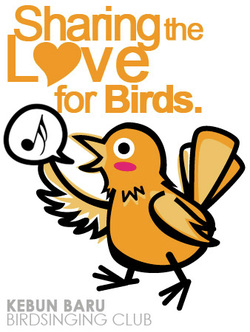|
Regn No ROS 2070/2008
|
AN UNIQUE CORNER OF SINGAPORE
Located at the foot of a hill, which is part of Ang Mo Kio Garden West, the Kebun Baru Birdsinging Club facility has a capacity to accommodate more than 1000 cages. On competition days, temporary tentage has to be erected to accept more cages. Every morning, sans rain, and as early as 6am, merbok or zebra doves are hoisted up 20ft high poles for training. They are hoisted up by a simple pulley system. These birds, with a greyish face and a pinkish brown body, are encouraged to sing when in the presence of many of their own kind.
Although these birds are ground feeders, they are hoisted up so high in the open field because they like plenty of sunshine. When being transported, the cages are covered with a cloth to prevented the merbok from being frightened. The merbok field has a total of 426 poles. Under the shelter there are scores of hooks for cages in case of inclement weather. A short walk away, under shelters, there are cages of longtail shama or white-rumped shama. The shama is an expensive bird and may cost thousands of dollars depending on its quality. It is judged on its singing ability, tonal quality, stamina, liveliness, length of tail, beauty and frequent up-down movement of tail. Cages of the jambul or red whiskered bulbul can be seen near the shama. The jambul is a fascinating sight to watch. It has a red whiskered patch below its eye, black pointed crest, greyish brown wings and white breast. When a female jambul is nearby, it would sing with an open tail and crest, and spread its wings. This bird was depicted on the $5 Singapore currency note (bird series).
Elsewhere, there are small cages of mata puteh (aka oriental white-eye or white-eye zosterops). With tonal yellowish-olive feathers, these birds are about 3-inch from beak to tail. It has a white ring round its eyes. Hence, its name. When hobbyists submit their birds for competition, they do not really go for the prizes. They are more keen to see who has the champion bird and thus a more valuable pet. There is also an area for the display of other kinds of birds. These birds are kept for their beauty, for admiration and enjoyment. They include the hwa mei (china thrush), magpie robin, canary, red siskin, skylark, with a tall cage for it to hover; orange-headed thrush, straw-headed bulbul, blue-white flycatcher and others. Although there are a variety of birds here, only the merbok, shama, mata puteh and jambul are for competitions. To make the place even more vibrant and festival-like, a separate section is planned for a parrot parade. It will be designated for the display of the macaw, with its colourful plumage; sulphur-crested cockatoo, african grey, green amazon and other types of parrots.
The whole recreational facility forms an unique corner of Singapore. It is the largest bird singing and display arena in the country and one of the largest of its kind in Southeast Asia. It is conducive and ideally suited for such activity. There is lush greenery on the nearby hill, a big carpark with broad-canopy raintrees, wrought-iron benches, food outlets and a market. The area has not only attracted bird lovers but also casual local visitors, expatriates and tourists. On some weekends, there are busloads of visitors from other parts of Singapore. The best birds are brought here for training and competition, not only from Ang Mo Kio but also from as far as Pasir Ris, Jurong or Woodlands. The hustle and bustle of activity is ongoing on a daily basis, every morning from 6am to noon, with the biggest crowds on weekends and public holidays. Besides having been featured in videos and magazines, a little known fact was that the area was used as a site location for a few scenes for the movie "Cages" in 2004. |







